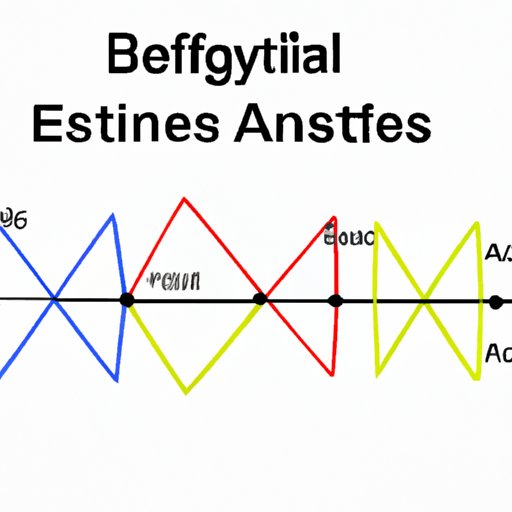
I. Introduction
Finding the line of best fit is a crucial concept in data analysis. It helps us understand the relationship between variables and make predictions about future trends. In this article, we will explore various methods for finding the line of best fit and how to ensure accuracy in the process.
II. Mastering the Art of Regression: How to Find the Line of Best Fit
Regression analysis is a widely used method for finding the line of best fit. It helps identify the relationship between two or more variables and predicts future trends based on this relationship. The most common type of regression analysis is linear regression, which assumes a linear relationship between the variables being analyzed.
To find the line of best fit using linear regression, we need to calculate the slope of the line and the y-intercept. The slope is represented by the Greek letter beta (β) and can be calculated using the following formula:
β = (nΣ(xy) – ΣxΣy) / (nΣ(x^2) – (Σx)^2)
where n is the number of data points, x and y are the variables being analyzed, and Σ represents the sum of the values.
The y-intercept is represented by the Greek letter alpha (α) and can be calculated using the following formula:
α = (Σy – βΣx) / n
Once we have calculated the slope and y-intercept, we can plot the line of best fit on a graph and use it to make predictions about future trends.
III. Simplifying Linear Algebra: A Step-by-Step Guide to Finding the Line of Best Fit
To simplify the process of finding the line of best fit using linear algebra, we can break it down into simple steps. First, we need to calculate the means of the variables being analyzed. This is represented by the following formulas:
x̄ = Σx / n
ȳ = Σy / n
where x̄ and ȳ are the mean values for x and y, respectively.
Next, we need to calculate the variance and covariance of the variables being analyzed. Variance is the measure of how spread out a set of data is, while covariance measures the relationship between two variables. These can be calculated using the following formulas:
σ^2 = Σ(x – x̄)^2 / n
σxy = Σ(x – x̄)(y – ȳ) / n
Finally, we can calculate the slope and y-intercept using the following formulas:
β = σxy / σx^2
α = ȳ – βx̄
Once we have calculated the slope and y-intercept, we can plot the line of best fit on a graph and use it to make predictions about future trends.
IV. The Importance of Accuracy: How to Find the Line of Best Fit for Better Predictions
Accuracy is crucial in data analysis, and finding the line of best fit is no exception. An accurate line of best fit can provide better predictions about future trends, while an inaccurate one can lead to poor decisions and incorrect conclusions.
Several factors contribute to the accuracy of the line of best fit, including the number of data points, the shape of the data distribution, and the type of regression analysis used. To ensure accuracy in the process, it is important to use a large sample size and to choose the appropriate regression model based on the nature of the variables being analyzed.
Examples of how the line of best fit can be used to predict future trends include forecasting sales based on historical data or predicting the spread of a virus based on infection rates.
V. Data Science 101: Finding the Line of Best Fit
In data science, finding the line of best fit involves several key concepts, including R-squared, residuals, slope, and intercept. R-squared measures the proportion of variance in the dependent variable that can be explained by the independent variable, while residuals represent the difference between the actual values and the predicted values.
To calculate R-squared, we need to first calculate the sum of squares total (SST), which measures the total variability in the data. This is represented by the following formula:
SST = Σ(y – ȳ)^2
Next, we need to calculate the sum of squares residual (SSR), which measures the variability that is not explained by the regression model:
SSR = Σ(y – y’)^2
where y’ is the predicted value for y based on the regression model.
Finally, we can calculate R-squared using the following formula:
R² = 1 – (SSR / SST)
The slope and intercept can be calculated using the formulas described in previous sections.
VI. Maximizing Correlation Analysis: How to Find the Line of Best Fit for Big Data
Finding the line of best fit can be challenging when dealing with big data sets that contain a large number of variables. However, it can also provide valuable insights that could have a significant impact on business or industry.
One way to increase the accuracy of correlation analysis for big data sets is to use machine learning algorithms that can identify patterns and relationships between variables. This can help identify the variables that are most important for predicting future trends and improve the accuracy of the line of best fit.
Examples of how finding the line of best fit can be used in correlation analysis for big data include predicting customer behavior based on purchasing habits or identifying trends in social media data to make marketing decisions.
VII. Conclusion
Finding the line of best fit is a crucial concept in data analysis that can provide valuable insights into relationships between variables and future trends. By mastering the art of regression and simplifying linear algebra, we can ensure accuracy in the process and make better predictions about the future. It is important to remember that accuracy is key, and choosing the appropriate regression model based on the nature of the variables being analyzed can make all the difference.
We encourage readers to explore this topic further and experiment with different methods for finding the line of best fit to gain deeper insights into their data.





